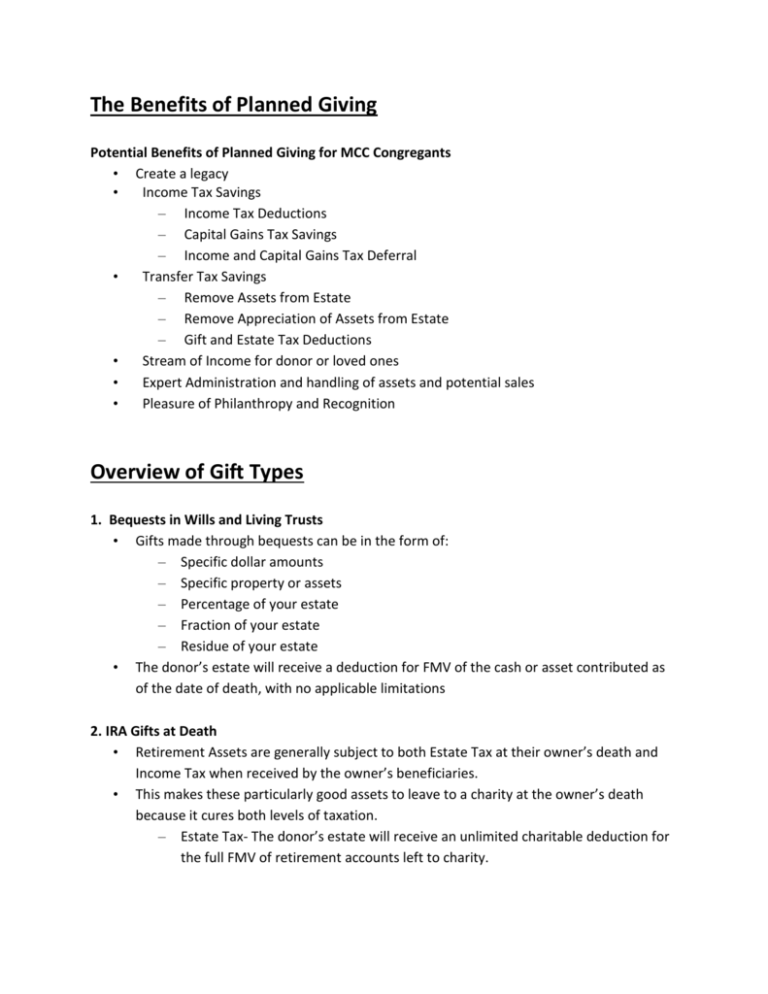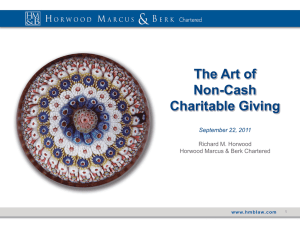The Benefits of Planned Giving
advertisement

The Benefits of Planned Giving Potential Benefits of Planned Giving for MCC Congregants • Create a legacy • Income Tax Savings – Income Tax Deductions – Capital Gains Tax Savings – Income and Capital Gains Tax Deferral • Transfer Tax Savings – Remove Assets from Estate – Remove Appreciation of Assets from Estate – Gift and Estate Tax Deductions • Stream of Income for donor or loved ones • Expert Administration and handling of assets and potential sales • Pleasure of Philanthropy and Recognition Overview of Gift Types 1. Bequests in Wills and Living Trusts • Gifts made through bequests can be in the form of: – Specific dollar amounts – Specific property or assets – Percentage of your estate – Fraction of your estate – Residue of your estate • The donor’s estate will receive a deduction for FMV of the cash or asset contributed as of the date of death, with no applicable limitations 2. IRA Gifts at Death • Retirement Assets are generally subject to both Estate Tax at their owner’s death and Income Tax when received by the owner’s beneficiaries. • This makes these particularly good assets to leave to a charity at the owner’s death because it cures both levels of taxation. – Estate Tax- The donor’s estate will receive an unlimited charitable deduction for the full FMV of retirement accounts left to charity. – • • Income Tax- Nonprofits are tax exempt so no income tax will be due as the organization receives the assets or payments from the retirement accounts. Testamentary gifts of IRA’s to charity are very easy to designate and change through Beneficiary Designation forms. The donor does not have to amend their Trust and Will to change charities. Beneficiaries can be designated as sole beneficiaries or accounts can be divided amongst various beneficiaries in different percentages 3. IRA Gifts During Life • A gift from a traditional IRA to charity will typically be tax neutral to the donor. They will have to recognize the income from the withdrawal but will receive a deduction for a corresponding amount. • The tax free IRA Rollover Gifts to Charities was extended through 2013. • The IRA Charitable Rollover allows donors to make a transfer directly from their IRA to charity and not have to recognize the income while still satisfying their required minimum distributions. • Donor must be 70 ½ or older. • Gift must be paid directly from the custodian to charity. • A maximum of $100,000 a year is allowed per donor. • A rollover gift can not be used to fund a split interest gift. 4. Charitable Split Interest Trusts • A Split Interest Trust potentially allow donors to: – Defer/avoid paying capital gains tax on the sale of appreciated assets – Remove assets and their appreciation from estate tax liability – Retain income stream or reversionary interest in assets – Receive an immediate income tax deduction – Be recognized as a current donor by charity – Experience the thrill of philanthropy and seeing their money at work – Receive a better rate of return on investments than currently available with little risk 5. Charitable Split Interest Trusts- CRT • A Charitable Remainder Trust is an irrevocable trust with a current income interest for donors or their loved ones and a remainder interest to charity. – Can be established during donor’s life or upon their death – Can be measured by donors’ life/lives, the life/lives of loved ones or a term of years – – – Donor receives an immediate income tax deduction for present value of the remainder interest (the gift to charity) Qualified CRT’s are tax exempt so they do not pay income tax. Income and gain recognized by these trust can carry out to the beneficiaries on their Schedule K1’s. Two Types of CRTs: • Charitable Remainder Annuity Trusts (CRAT) provide a fixed income based on a percentage of the initial value of the trust assets as determined on contribution. Once funded additional assets may not be added to it in the future. • Charitable Remainder Unitrusts (CRUT) provide a variable income based on a percentage of the annual value of the trust assets as determined each year. A donor can make additional contributions to a CRUT at any time, receiving an additional deduction and increasing their annual payout. 6. Charitable Split Interest Trusts- CLT • A Charitable Lead Trust is an irrevocable trust with current income interest for charity and remainder interest to donor or their loved ones – Can be established during donor’s life or upon their death – Can be measured by donors’ life/lives, the life/lives of loved ones or a term of years – Donor often does not receive an income tax deduction for funding a CLT. These trusts are most commonly used as a transfer tax reduction tool. – Unlike CRT’s, CLT’s are not tax exempt and are subject to tax – Two Types of CLTs: • Charitable Lead Annuity Trusts (CLAT) provide a fixed income based on a percentage of the initial value of the trust assets as determined on contribution. • Charitable Lead Unitrusts (CLUT) provide a variable income based on a percentage of the annual value of the trust assets as determined each year. 7. Charitable Gift Annuities • A charitable gift annuity is a contract between a charity and the donor – Donor agrees to provide a certain amount or asset to the charity – The charity agrees to pay an annual fixed amount for life of annuitant or annuitants • • The charity’s obligation – The charity is contractually obligated to make all the payments – The annuity obligation is secured by all of the assets of the charity Tax Considerations – A portion of the annual annuity payments will be tax free return of principal – Donor receives an income tax deduction for the actuarial present value of the remainder interest (the gift to charity) 8. Charitable Gift Annuities • Potentially allows you to: – Defer paying capital gains tax on the sale of appreciated assets – Remove assets and their appreciation from estate tax liability – Retain guaranteed and fixed income stream for life – Receive an immediate income tax deduction – Be recognized as a current donor by charity – Experience the thrill of philanthropy and seeing their money at work – Receive a better rate of return than currently available with no risk – Benefit from partially tax free payments 9. Real Estate • Bargain Sale- Donor sells real estate to a charity at a significantly discounted price and can take a deduction for the difference between the amount paid by the charity and the FMV. The charity can turn around and sell it for FMV. • Reserved Life Estate- Donor makes an irrevocable gift to a charity of the remainder interest after their life of their residence or farm. • FLIP NIMCRUT- A Charitable Remainder Trust that pays out the lesser of net income and a percentage of trust assets. Is often used when a Trust will be funded with real estate to avoid liquidity issues. • Outright Gift of Real Estate- Can be deducted for the full FMV on the date of the gift in the year of contribution up to 30% of the donor’s AGI for that year. • An appraisal is necessary to substantiate the FMV for a deduction of $5,000 or more. 10. Tangible Personal Property Gifts • Tangible Personal Property includes cars, boats, art, jewelry, gold & silver, etc. A physical item that can generally be moved. – Related Use- Can be deducted for full FMV of the item on the date of the gift in the year of contribution up to 30% of donor’s AGI for that year. If the charity • sells the item within 3 years of receipt then the donor will likely be subject to additional tax liability. – Unrelated Use- Deduction is limited to donor’s cost basis and can be deducted in the year of contribution up to 50% of donor’s AGI for that year. Exception for coins that have no collectible (numismatic) value- treated same as cash Form 8282 (tattletale form)- The charity must file this form if they sell the asset within three years of receipt 11. Outright Gifts During Your Life • Outright gifts to charity can qualify donors for an immediate income tax deduction. The amount of deduction both allowable and actually allowed depend on the type of asset: – Cash: Deductions are allowable up to amount of cash gifted and allowed up to 50% of donor’s AGI for the year – Appreciated property: (real estate, securities, etc.) Deductions are allowable up to FMV on date of contribution and are allowed up to 30% of donor’s AGI for the year (short term capital gain property deductions are allowable only to donor’s cost basis in such asset and are allowed up to 50% of AGI) – Tangible Personal Property: Deductions are allowable up to FMV on date of contribution if that property will be used in a manner related to the charity’s exempt purpose and are allowed up to 30% of donor’s AGI for the year. If the property will not be used in a manner related to the charity’s exempt purpose, the deduction is allowable only to the donor’s cost basis in such asset and is allowed up to 50% of donor’s AGI for the year • Deductions for all of the above assets can be carried forward for up to five years to the extent disallowed If You’ve Been Thinking… • • • • I recently sold a large asset and am going to have a huge tax bill this year. Now that I am 70, I have to start taking the required minimum distributions from my IRA, even though I really don’t need the income and am worried about the tax consequences. I have a highly appreciated asset, whether it be specific stock or investment real property. If I sell it or leave it in my will, the capital gains taxes will be enormous. My spouse recently passed and left me a large amount of stock, most of which is stock in the company she worked for. • • I have enough assets to be concerned about estate tax (currently $5.25 million), yet I’m still having concerns about running out of money if I give too much away. I would love to be able to help MCC San Diego, but I am concerned about having sufficient income when I retire. …It May be Beneficial for You to Speak with an Estate Lawyer Recent Changes to the Tax Laws A Few Key Provisions of the American Taxpayers Relief Act of 2012 • Created new highest income tax bracket of 39.6% for taxpayers with at least $400,000 of income if single and at least $450,000 of income if married and filing jointly • Individuals in the 39.6% tax bracket will also pay 20% in long term capital gains, while most taxpayers will still pay 15% • Made $5 million unified estate and gift tax exemption permanent (indexed for inflation so $5.25 million in 2013) • The highest gift, estate and GST tax rates are now all 40% • Brought back the Pease provision that reduces certain itemized deductions (including the charitable deduction) for taxpayers with at least $250,000 of income if single and at least $300,000 of income if married and filing jointly • Reinstated the IRA Charitable Rollover for 2013 and retroactively for 2012






